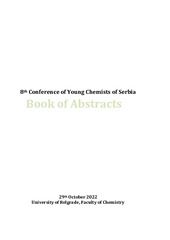Приказ основних података о документу
Extraction of polyphenols from orange peel and their controlled release from pH-sensitive hydrogels
| dc.creator | Miladinović, Nina N. | |
| dc.creator | Marković, Maja | |
| dc.creator | Pjanović, Rada | |
| dc.date.accessioned | 2022-10-31T11:07:45Z | |
| dc.date.available | 2022-10-31T11:07:45Z | |
| dc.date.issued | 2022 | |
| dc.identifier.isbn | 978-86-7132-080-1 | |
| dc.identifier.uri | http://TechnoRep.tmf.bg.ac.rs/handle/123456789/5228 | |
| dc.description.abstract | Several million tons of orange peel are generated annually as a result of the industrial processing of this fruit. Orange peels are rich in polyphenols, that show antioxidant activity. Hence, converting orange peels into antioxidant extract by using green eutectic solvents (GES) would be a good solution. GES represent a mixture of organic substances that are not harmful to human health, environmentally friendly and highly selective towards the targeted active substance. The aim of this work was the extraction of polyphenols from orange peel waste using a GES based on urea and glycerol, their encapsulation into hydrogels based on poly(methacrylic acid) (PMAA), and controlled release from these hydrogels. PMAA are non-toxic, biocompatible and pH sensitive, so they are widely used for the targeted delivery of active substances. Swelling of PMAA and the controlled release of polyphenols from PMAA were monitored in two mediums with different pH values: 0.1 M hydrochloric acid (pH=1) and phosphate buffer (pH=6.8) at 37 °C. The influence of the crosslinker amount and neutralization degree of methacrylic acid (ND) on the PMAA swelling and the release of polyphenols was examined. The kinetics of PMAA swelling and polyphenol release were analyzed using the Peppas model. It was concluded that the swelling degree of PMAA increased with an increase in pH value of medium and ND, and decreased with an increase in crosslinker amount. As a consequence, the cumulative release of polyphenols was around three times higher in pH=6.8 than in pH=1 for both series of the samples. Peppas model showed that diffusion was the primary mechanism of polyphenols release for most samples. Based on the analysis of the results, it is concluded that the sample with optimal characteristics for the controlled release of polyphenols is the sample with 0% neutralized methacrylic acid and 0.4 mol% MBA. | sr |
| dc.language.iso | en | sr |
| dc.publisher | Serbian Chemical Society and Serbian Young Chemists’ Club, Belgrade, Serbia | sr |
| dc.relation | info:eu-repo/grantAgreement/MESTD/inst-2020/200287/RS// | sr |
| dc.rights | openAccess | sr |
| dc.rights.uri | https://creativecommons.org/licenses/by/4.0/ | |
| dc.source | 8th Conference of Young Chemists of Serbia Book of Abstract | sr |
| dc.title | Extraction of polyphenols from orange peel and their controlled release from pH-sensitive hydrogels | sr |
| dc.type | conferenceObject | sr |
| dc.rights.license | BY | sr |
| dc.citation.spage | 88 | |
| dc.identifier.fulltext | http://TechnoRep.tmf.bg.ac.rs/bitstream/id/12911/bitstream_12911.pdf | |
| dc.identifier.rcub | https://hdl.handle.net/21.15107/rcub_technorep_5228 | |
| dc.type.version | publishedVersion | sr |

